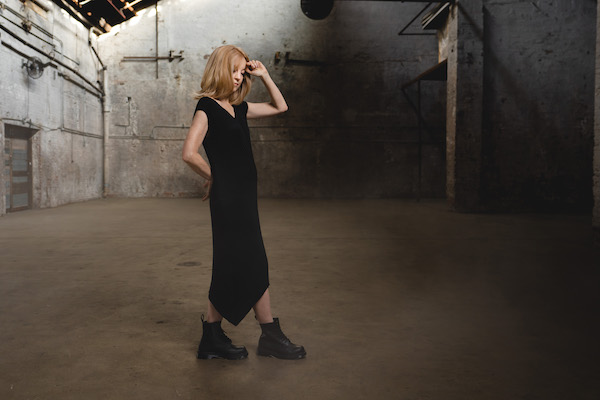Dec 9, 2025 12:28 PM
In Memoriam: Gordon Goodwin, 1954–2025
Gordon Goodwin, an award-winning saxophonist, pianist, bandleader, composer and arranger, died Dec. 8 in Los Angeles.…

Maria Schneider’s new release is a double album titled Data Lords.
(Photo: Briene Lermitte)The first of Data Lords’ two discs is subtitled The Digital World, while the second CD is called Our Natural World. Together, they constitute Schneider’s fifth project created and documented through ArtistShare, the crowdfunding platform that she first used to create her 2004 album Concert In The Garden.
“I wanted the music on this album, especially the first disc, to be very evocative and grab you in some kind of way, even if it feels disturbing,” Schneider said during a mid-June phone conversation. “It had to have something else to it. I wanted it to feel like something, rather than sound like something.”
She cited the album’s title track as a prime example. “There were certain figures where I asked the band to create a sense of ricocheting off of something or having one instrument playing violently vibrato, so that there’s kind of an intensity and a rawness that feels improvised and doesn’t feel too tight or too perfect,” she said. “It takes some time for everybody to feel the form of the piece. It’s not something you can just read.
“At one point, the brass are hitting these bouncing figures, and rather than being rhythmically notated, I’m conducting those and literally thrusting my hands down and making them bounce and get faster as the motion gets smaller, like a ball would. I was surprised how quickly the band responded to that, but it has taken us quite a lot of performances to get the timing of those with the soloist and the rhythm section.”
At the 2017 Newport Jazz Festival, the Maria Schneider Orchestra debuted “Don’t Be Evil,” a piece commissioned through ArtistShare by David and Ginger Komar. It musically mocks Google, and its title refers to a motto that formerly was part of the company’s official code of conduct.
“This was a piece where a lot developed in the performance of it,” Schneider said of the 13-minute song. “When I first listened to [the band run through it], I said, ‘Oh, this doesn’t sound like mockery, but I’m mocking Google.’ So, I started asking some of the horn players to play with a very over-the-top vibrato, kind of a na-na na na-na thing, so that really made a difference. And the same kind of concept applied when the full ensemble comes in at the end—that was another place where I felt it was too perfect. It sounded like a college big band. I was like, ‘No, no, no, it’s gotta have something raw.’ So, I changed the writing to make it a little bit more chromatic. I added a few trombone players doing a big vibrato, while others are doing the [more straightforward] figures just to create tension inside of the thing. It [evokes] this sort of world that’s overtaking us, that we’re so seduced by. It’s like a takeover of our economy, our psyches, our creativity, our children, our culture, our politics—all of it.”
Harmonically, “Don’t Be Evil” is based on a sequence of unusual-sounding chords established in the first eight bars. “The sound and color of those chords endure throughout the entire piece,” Schneider said. “They are all major sharp-11 sharp-9 chords. It’s a very unusual color, and I really like it because it’s dark, but it’s not brooding dark; it’s conflicted.”
The track “CQ CQ, Is Anybody There?” marks an even further departure for Schneider. It’s built entirely upon rhythms that spell out Morse code messages like “power,” “greed,” “S.O.S.” and “CQ” (ham radio code for “calling any station,” or, “is anyone there?”). A touch of humanity makes its way into the piece via the signal “W0ABF,” which was the ham radio call sign of Schneider’s late father.
“Sputnik” evokes the feeling of thousands of corporate satellites orbiting the planet, and “A World Lost” longs for a simpler time when humans were more connected to the earth, and to each other.

Goodwin was one of the most acclaimed, successful and influential jazz musicians of his generation.
Dec 9, 2025 12:28 PM
Gordon Goodwin, an award-winning saxophonist, pianist, bandleader, composer and arranger, died Dec. 8 in Los Angeles.…

Belá Fleck during an interview with Fredrika Whitfield on CNN.
Jan 13, 2026 2:09 PM
The fallout from the renaming of the John F. Kennedy Center for the Performing Arts to include President Donald…

Flea has returned to his first instrument — the trumpet — and assembled a dream band of jazz musicians to record a new album.
Dec 2, 2025 2:01 AM
After a nearly five-decade career as one of his generation’s defining rock bassists, Flea has returned to his first…

Dec 11, 2025 11:00 AM
DownBeat presents a complete list of the 4-, 4½- and 5-star albums from 2025 in one convenient package. It’s a great…

The success of Oregon’s first album, 1971’s Music Of Another Present Era, allowed Towner to establish a solo career.
Jan 19, 2026 5:02 PM
Ralph Towner, a guitarist and composer who blended multiple genres, including jazz — and throughout them all remained…